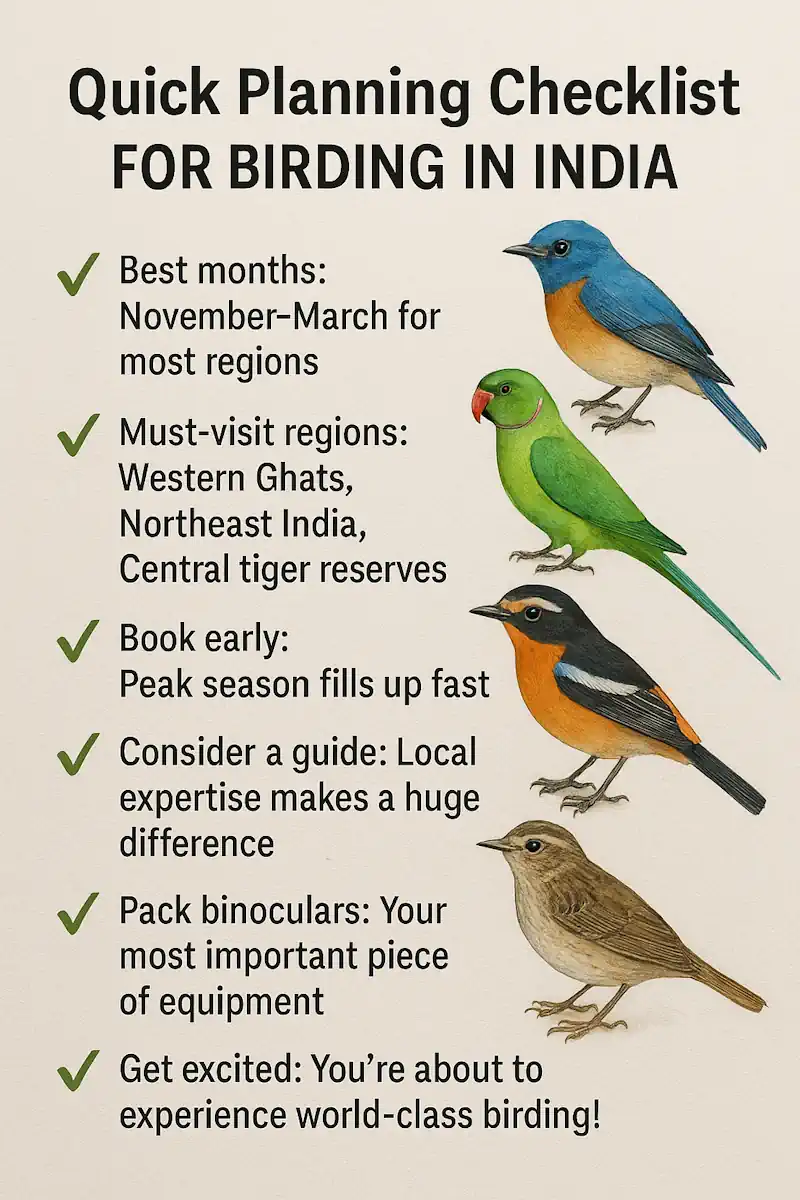If you’re serious about bird watching, you’ll want to add India to your bucket list. With over 1,300 bird species — that’s 12% of all the world’s birds in one country — India offers some of the most spectacular birding experiences on Earth.
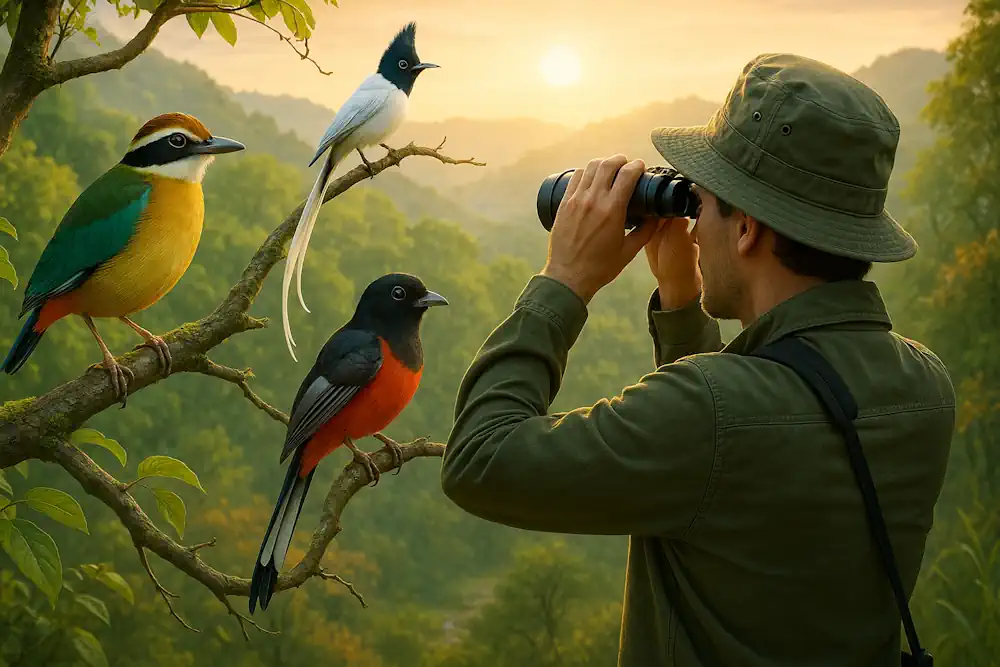
Whether you’re hoping to spot a majestic Great Hornbill in the Western Ghats or catch a glimpse of the elusive Snow Leopard’s feathered neighbors in the high Himalayas, India delivers birding adventures that’ll keep you coming back for more.
Why India is a Birder’s Paradise
Here’s what makes India absolutely incredible for birding: 83 endemic species that you literally can’t see anywhere else on the planet. From the vibrant Malabar Trogon to the critically endangered Forest Owlet, these birds exist nowhere else in the world. Add to that another 161 “near-endemic” species primarily found in the Indian subcontinent, and you’ve got a birding destination that’s truly one-of-a-kind.
But it’s not just about the numbers. India’s incredible diversity of habitats — from the snow-capped Himalayas to tropical rainforests, arid deserts to vast wetlands — means every region offers completely different birding experiences. You could spend a lifetime exploring and still discover new species.
When to Plan Your India Birding Tour
The best time for most India birding tours is October through April, when resident species are joined by massive numbers of migratory birds from across Europe and Asia. The weather is also perfect during these months — not too hot, not too cold, just right for spending long days in the field.
That said, India’s diversity means there’s great birding year-round:
- November to March: Peak season with the most comfortable weather and maximum species diversity
- April to June: Hot but great for Himalayan species and summer migrants
- July to September: Monsoon season brings lush landscapes and breeding activity
- October: Migration starts, with fresh arrivals daily
India’s Top Birding Regions
The Western Ghats: Endemic Central
Running along India’s west coast, the Western Ghats are home to 29 endemic bird species — more than anywhere else in India. This ancient mountain range harbors incredible diversity, from the massive Great Hornbill to tiny sunbirds that seem to glow in the dappled forest light.
Must-see species: Malabar Grey Hornbill, Blue-winged Parakeet, Malabar Trogon, White-bellied Treepie, and the stunning Crimson-backed Sunbird.
Northeast India: The Hidden Gem
Ask any serious birder about their dream destination in India, and they’ll tell you: Eaglenest Wildlife Sanctuary in Arunachal Pradesh. This is where the famous Bugun Liochichla was discovered in 2006 — a bird so special it’s named after the local tribe. With nearly 500 species recorded and pristine forests, Northeast India offers some of the most exciting birding in the world.
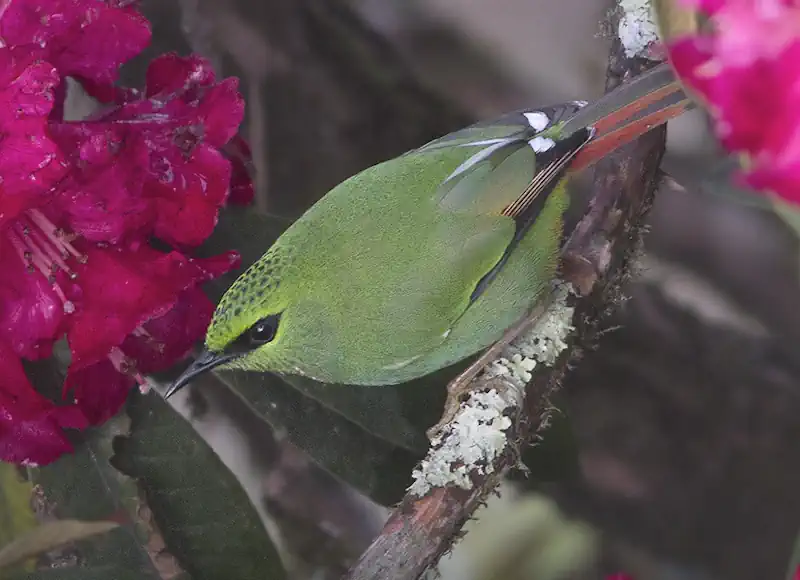
The Fire-tailed Myzornis (shown above) is one of the most sought-after species in Northeast India. This stunning bird, with its brilliant orange tail and intricate plumage patterns, represents exactly why Eaglenest has become a pilgrimage site for serious birders worldwide.
Must-see species: Bugun Liochichla, Ward’s Trogon, Beautiful Nuthatch, and Fire-tailed Myzornis.
Central India: Tiger Country Birding
Who says you have to choose between tigers and birds? India’s central tiger reserves like Pench, Satpura, and Kanha offer fantastic birding alongside your wildlife safari. The mix of dry deciduous forests, grasslands, and water bodies creates a perfect habitat for both forest and open-country species.
Must-see species: Indian Pitta, Painted Spurfowl, Orange-headed Thrush, and various hornbills.
The Himalayas: High-Altitude Specialists
From the foothills to elevations over 4,000 meters, the Himalayas offer birding like nowhere else. This is where you’ll find Snow Partridge, Himalayan Monal, and other high-altitude specialists that have adapted to life in the mountains.
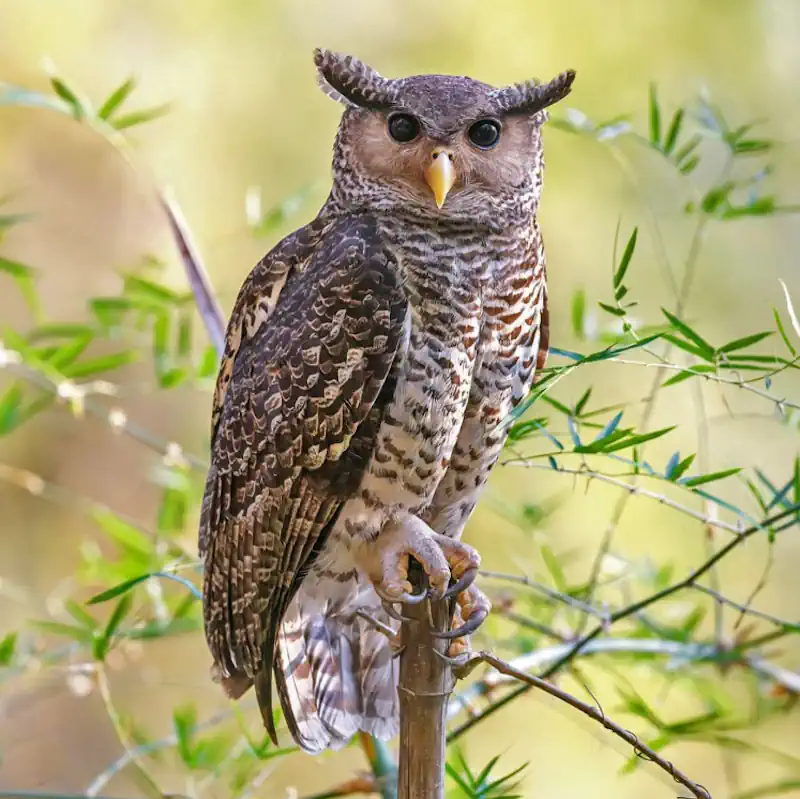
The magnificent Spot-bellied Eagle Owl (above) exemplifies the incredible raptors you’ll encounter in the Himalayan regions. These powerful nocturnal hunters are perfectly adapted to the mountain forests of places like Sikkim, where patient birders are rewarded with unforgettable sightings.
Must-see species: Himalayan Monal, Snow Partridge, Lammergeier, and various rosefinches.
Wetlands: Migration Central
India’s wetlands, from famous Bharatpur (Keoladeo) to lesser-known gems like Maguri Beel in Assam, become bird metropolises during the migration season. Imagine thousands of waterfowl, waders, and raptors all in one place — it’s absolutely magical.
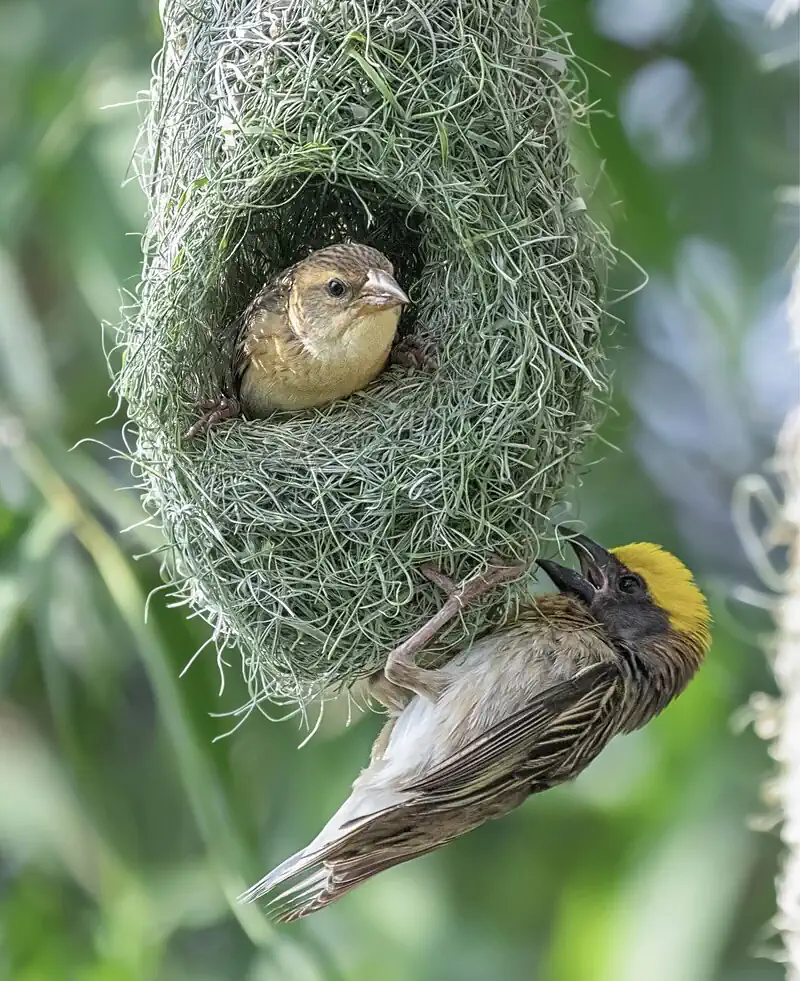
The industrious Baya Weaver (shown above) is a perfect example of the incredible diversity you’ll find at India’s premier wetland destinations. These master architects create intricate hanging nests that are as impressive as they are functional, often spotted in large colonies at places like Bharatpur Bird Sanctuary.
Must-see species: Sarus Crane, Bar-headed Goose, various ducks and waders, plus raptors galore.
Planning Your India Birding Adventure
Choosing Your Route
With so much to see, planning can feel overwhelming. Here are some tried-and-tested approaches:
The Classic Northern Circuit: Delhi → Corbett → Bharatpur → Ranthambore
Perfect for first-timers, combining iconic sites with good infrastructure.
The Western Ghats Experience: Mumbai → Pune → Goa → Karnataka
Focus on endemic species in stunning landscapes.
The Northeast Adventure: Guwahati → Kaziranga → Eaglenest → Nameri
For serious birders seeking rare and endemic species.
The Central India Wildlife Special: Delhi → Pench → Satpura → Kanha
Combine tiger safaris with excellent birding.
What to Pack
- Binoculars: Essential — 8×42 or 10×42 are ideal
- Field guide: “Birds of India” by Grimmett, Inskipp, and Inskipp is the gold standard
- Camera with telephoto lens: For those once-in-a-lifetime shots
- Appropriate clothing: Layers for varying temperatures, neutral colors
- Notebook: For recording your sightings and life birds
Guided vs. Independent Birding
While India can be explored independently, having a knowledgeable local guide makes an enormous difference. They know where to find specific species, can identify birds by call, and help navigate language barriers. Plus, many of the best birding spots require local knowledge to access.

What Makes India Birding Special
Beyond the incredible species diversity, birding in India offers something you won’t find elsewhere: the cultural context. Birds are deeply woven into Indian culture — the Sarus Crane symbolizes fidelity, the Indian Peafowl is revered in Hindu tradition, and the arrival of the Pied Cuckoo heralds the monsoon season.
You’ll also find that birds in India are generally quite approachable. Unlike in heavily hunted areas, many species here aren’t as fearful of humans, making for fantastic viewing and photography opportunities.
Conservation and Responsible Birding
India’s birds face challenges from habitat loss and climate change, but there’s also incredible conservation work happening. By choosing responsible tour operators and staying at eco-lodges, you’re directly supporting conservation efforts. Many birding destinations in India are success stories — places where tourism has made wildlife more valuable alive than dead.
Your India Birding Journey Awaits
Whether you’re a casual bird watcher or a hard-core lister, India offers birding experiences that will exceed your wildest expectations. From the moment you spot your first Indian Roller displaying its electric blue wings to the day you finally see that long-sought endemic, India will capture your heart.
The key is to start planning now. The best birding spots fill up quickly during peak season, and the most experienced guides are in high demand. But trust us — once you experience birding in India, you’ll understand why so many birders consider it the ultimate destination.
Ready to start your India birding adventure? The birds are waiting.
Quick Planning Checklist
- ✓ Best months: November-March for most regions
- ✓ Must-visit regions: Western Ghats, Northeast India, Central tiger reserves
- ✓ Book early: Peak season fills up fast
- ✓ Consider a guide: Local expertise makes a huge difference
- ✓ Pack binoculars: Your most important piece of equipment
- ✓ Get excited: You’re about to experience world-class birding!
